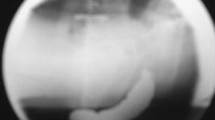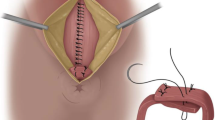Abstract
INTRODUCTION: Rectocele may be associated with both chronic constipation and anal incontinence. Several different surgical procedures have been advocated for rectocele repair. The aim of the present study was to evaluate anorectal function and clinical outcome in a consecutive series of patients who underwent selected endorectal or transperineal surgery for rectocele for whom operative treatment was determined by clinical and proctographic features. Attention was paid to the cohort of rectocele patients presenting with incontinence as a leading symptom. METHODS: Sixty consecutive patients with symptomatic rectocele underwent surgical treatment at our institution. Fifty-eight of the patients were female (mean age 56; range, 21–70 years). Incontinence was graded according to a previously reported scoring system that accounts for the type and frequency of incontinence episodes. Preoperative anorectal manometry was performed using an open perfused polyethylene probe. Rectal sensation was recorded by balloon distention. Endoanal ultrasonography was performed with a 7.5-MHz probe. Preoperative defecography was performed at rest and on maximal squeeze and straining. Patients with obstructed defecation as their principal symptom, with associated mucosal rectal prolapse, underwent an endorectal procedure. For patients with associated anal incontinence (Grade B2 or greater), and without a rectal mucosal prolapse, a transperineal approach was performed with either an anterior external overlapping sphincteroplasty or levatorplasty. The median follow-up was 48 (range, 9–122) months. RESULTS: There was no operative mortality. Postoperative complications occurred in 18 patients (30 percent). Of 43 patients with incontinence, 34 (79 percent) were available for postoperative evaluation. None were fully continent. However, in 25 patients (73.5 percent), continence improved after surgery; half had only mucus soiling or loss of gas. Incontinence scores decreased (i.e., improved) from 4.8 ± 0.9 to 3.9 ± 0.9 (P = 0.002). A significant improvement was found both after transanal and perineal procedures. Only ten initially continent patients were available for postoperative assessment. All patients stated that they had clinical improvement in constipation. Their preoperative mean anal resting pressure was 62.5 ± 3.9 (standard error of the mean) mmHg, with a postoperative mean of 75.5 ± 7 mmHg. The preoperative mean squeeze pressure was 83.1 ± 8.5 mmHg, with a mean postoperative squeeze pressure of 88.5 ± 7.9 mmHg (P = not significant). The maximal tolerable volumes were all within normal limits, confirming the proctographic evidence that there were no cases of megarectum in our patient series. The pudendal nerve terminal motor latency was abnormal in all but two patients with incontinence (mean pudendal nerve terminal motor latency = 3.1; range, 1.2–4 milliseconds). Rectoceles recurred in six patients (10 percent): five after a Block procedure and one after a Sarles-type operation. The postoperative endosonographic appearance varied according to the nature of the procedure performed. CONCLUSION: There are few data concerning patients with rectocele who have associated anal incontinence, however, surgical decision analysis resulted in improvement in both constipation and incontinence in the majority of our patients with rectocele. Nevertheless, because none of the patients gained full continence postoperatively, pelvic floor rehabilitation might be also needed to achieve better sphincter function in patients with incontinence.
Similar content being viewed by others
References
F Pucciani ML Rottoli A Bologna et al. (1996) ArticleTitleAnterior rectocele and anorectal dysfunction. Int J Colorectal Dis 11 1–9
MC Marti B Roche J Deleaval (1999) ArticleTitleRectoceles: Colorectal Dis 1 324–329
K Glavind H Madsen (2000) ArticleTitleA prospective study of the discrete fascial defect rectocele repair. Acta Obstet Gynecol Scand 79 145–147
SJ Watson PB Loder S Halligan et al. (1996) ArticleTitleTransperineal repair of symptomatic rectocele with Marlex mash: J Am Coll Surg 183 257–261
IT Khubchandani JA Sheets JJ Stasik AR Hakki (1983) ArticleTitleEndorectal repair of rectocele. Dis Colon Rectum 26 792–796
R Silvis HG Gooszen A van Essen AT de Kruif LW Janssen (1999) ArticleTitleAbdominal rectovaginopexy: Dis Colon Rectum 42 82–88
MF Paraiso T Falcone MD Walters (1999) ArticleTitleLaparoscopic surgery for enterocele, vaginal apex prolapse and rectocele. Int Urogynecol J Pelvic Floor Dysfunct 10 223–229
M Pescatori G Anastasio C Bottini A Mentasti (1992) ArticleTitleNew grading and scoring for anal incontinence: Dis Colon Rectum 35 482–487
M Pescatori U Favetta S Dedola S Orsini (1997) ArticleTitleTransanal stapled excision of rectal mucosal prolapse. Techn Coloproctol 1 96–98
M Pescatori C Quondamcarlo (1999) ArticleTitleA new grading of rectal internal mucosal prolapse and its correlation with diagnosis and treatment. Int J Colorectal Dis 14 245–98
IR Block (1986) ArticleTitleTransrectal repair of rectocele using obliterative suture. Dis Colon Rectum 29 707–711
JC Sarles A Arnaud I Selezneff (1989) ArticleTitleEndorectal repair of rectocele. Int J Colorect Dis 4 169–171
JA Ferguson JR Heaton (1959) ArticleTitleClosed hemorrhoidectomy. Dis Colon Rectum 2 176–179
F Agachan T Chen J Pfeifer P Reissman SD Wexner (1996) ArticleTitleA constipation scoring system to simplify evaluation and management of constipated patients. Dis Colon Rectum 39 681–685
LW Janssen CF van Dijke (1994) ArticleTitleSelection criteria for anterior rectal wall repair in symptomatic rectocele and anterior rectal wall prolapse. Dis Colon Rectum 37 1100–1107
P Shorvon S McHugh N Diamant S Somers G Stevenson (1989) ArticleTitleDefecography in normal volunteers: Gut 30 1737–1749
KH Ting E Mangel B Eibl Eibesfeldt SA Muller Lissner (1992) ArticleTitleIs the volume retained after defecation a valuable parameter at defecography? Dis Colon Rectum 35 762–767
S Halligan CI Bartram (1995) ArticleTitleIs barium trapping in rectoceles significant? Dis Colon Rectum 38 764–768
VK Murthy BA Orkin LE Smith LM Glassman (1996) ArticleTitleExcellent outcome using selective criteria for rectocele repair. Dis Colon Rectum 39 374–378
J Tsiaoussis E Chrysos M Glynos JS Vassilakis E Xynos (1998) ArticleTitlePathophysiology and treatment of anterior rectal mucosal prolapse syndrome. Br J Surg 85 1699–1702
CJ Van Laarhoven MA Kamm CI Bartram S Halligan PR Hawley RK Phillips (1999) ArticleTitleRelationship between anatomic and symptomatic long-term results after rectocele repair for impaired defecation. Dis Colon Rectum 42 204–211
K Yoshioka Y Matsui O Yamada S Halligan PR Hawley RK Phillips (1991) ArticleTitlePhysiologic and anatomic assessment of patients with rectocele. Dis Colon Rectum 34 704–708
JH van Dam WM Huisman WC Hop WR Schouten (2000) ArticleTitleFecal continence after rectocele repair: Int J Colorect Dis 15 54–57
C Johansson BY Nilsson B Holmstrom A Dolk A Mellgren (1992) ArticleTitleAssociation between rectocele and paradoxical sphincter response. Dis Colon Rectum 35 503–509
JH van Dam WR Schouten AZ Ginai WM Huisman WC Hop (1996) ArticleTitleThe impact of anismus on the clinical outcome of rectocele repair. Int J Colorect Dis 11 238–242
A Ommer A Kohler S Athanasiadis (1998) ArticleTitleResults of transperineal levator-plasty in treatment of symptomatic rectocele [German]. Chirurg 69 966–972
YH Ho M Ang D Nyam M Tan F Seow-Choen (1998) ArticleTitleTransanal approach to rectocele repair may compromise anal sphincter pressures. Dis Colon Rectum 41 354–358
CW Lau S Heymen O Alabaz AJ Iroatulam SD Wexner (2000) ArticleTitlePrognostic significance of rectocele, intussusception, and abnormal perineal descent in biofeedback treatment for constipated patients with paradoxical puborectalis contraction. Dis Colon Rectum 43 478–482
MA Kahn SI Stanton (1998) ArticleTitleTechniques of rectocele repair and their effects on bowel function. Int Urogynecol J Pelvic Floor Dysfunct 9 37–47
U Karlbom W Graf S Nilsson L Pahlman (1996) ArticleTitleDoes surgical repair of a rectocele improve rectal emptying? Dis Colon Rectum 39 1296–1302
S Raz VW Nitti KJ Bregg (1993) ArticleTitleTransvaginal repair of enterocele. J Urol 149 724–730
RA Lee (1993) ArticleTitleVaginal hysterectomy with repair of enterocele, cystocele and rectocele. Clin Obstet Gynecol 36 967–975
M Albo MC DuPont S Raz (1996) ArticleTitleTransvaginal correction of pelvic prolapse. J Endourol 10 231–239
MW Arnold WR Stewart PS Aguilar (1990) ArticleTitleRectocele repair: Dis Colon Rectum 33 684–687
A Mellgren B Anzen BY Nilsson et al. (1995) ArticleTitleResults of rectocele repair: Dis Colon Rectum 38 7–13
MA Pelosi MA Pelosi (1997) ArticleTitleTransvaginal repair of recurrent rectovaginal fistula with laparoscopic-assisted rectovaginal mobilization. J Laparoendosc Adv Surg Tech 7 379–383
K Kenton S Shott L Brubaker (1999) ArticleTitleOutcome after rectovaginal fascia reattachment for rectocele repair. Am J Obstet Gynecol 181 1360–1363
CV Comiter SP Vasavada S Raz (1999) ArticleTitleTransvaginal colposuspension: Urology 54 819–822
Author information
Authors and Affiliations
About this article
Cite this article
Ayabaca, S.M., Zbar, A.P. & Pescatori, M. Anal Continence After Rectocele Repair. Dis Colon Rectum 45, 63–69 (2002). https://doi.org/10.1007/s10350-004-6115-2
Issue Date:
DOI: https://doi.org/10.1007/s10350-004-6115-2




